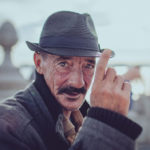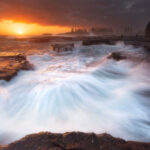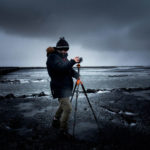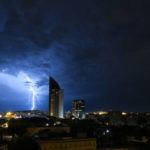The following video demonstrates the making of a Revolutionary War scene composite. The creators actually traveled to historically significant battle fields, specific to the Revolutionary War, to find the perfect background image. They then visited war reenactments for the fight scenes. The final composite is composed from five different photo shoots and approximately 22 images:
Let’s break down how to go about creating a Revolutionary War battle scene through composite photography.

First, the background plate must be shot, because it’ll lay the framework for the rest of the composite. In this particular case, the creators went about finding the perfect setting on an actual Revolutionary War battlefield, seen above. This image was taken in Concord where the Continental Army first fired on the British, an area called Battle Road, which later gives the entire composite a historical significance and accuracy. One thing to keep in mind is to maintain the same camera angle throughout all of the images to maintain uniformity, so you should decide upon what eye level your background image will be—and be happy with it, because you’ll be stuck with it for the remainder of the project!
Next, background battle images were shot to fill the top of the hill in the background image. These were taken at a war reenactment, without any form of cropping for easier editing later, and included the gun smoke and other texture details.
The foreground battle photos came next, and for this particular group, the photographer wanted and needed to maintain better control. He secured a group of reenactment professionals to gather and dedicate their time to helping him. He had to attempt to make the light match the pervious shots taken. To do this, he uses a strobe camera-right, behind the actors, to imitate sunlight that was present during the actual reenactment that the first set of battle images came from. The photo above was taken in an effort to convey movement, so the blur that is present was desired for believability.
The last battlefield images were the “hero shots”, and they had to be taken the next day during an entirely different light source, so again equipment was used to make all of the photographs as similar as possible. For the hero photos, the man playing the hero had to be seen in forward motion, therefore a makeshift motion rig was put to use. Check the bottom of this post for how to create the handmade motion rig implemented to create the above photo.
Finally, to pull it all together, the team created explosion images using special effects. This is highlighted in the video, but should not be tried at home unless you have a special effects professional on site.
The final product is then stitched together, edited for uniformity and believability, and any odd glitches or issues with positioning and camera angle are fixed digitally. For more specific information, take a look at the last few minutes of the video, though the more intricate details are not fully disclosed.
Here is the final composite:

Final Composite of all the Photos
Equipment used throughout this photo-shoot includes, but is not limited to:
- Dynalite 800 Pack
- Vanguard Alta Pro Tripod
- Photoflex Large Softbox
- Dynalight Portable Battery
- Motion Rig
To create the motion rig used in this project, you will need:
- Saw
- Screwdriver
- 2.5 inch screws
- One 2x2x4
- One 1x4x2
Cut the two-by-two at a 45 degree angle. Then simply center and attach the one-by-four to the end of the two-by-two, on the end you cut at an angle. This gives the perfect angle and length for the model/talent to lean on and create a look of forward motion and also allows you to easily make adjustments to positioning of limbs and clothing.
Like This Article?
Don't Miss The Next One!
Join over 100,000 photographers of all experience levels who receive our free photography tips and articles to stay current:









Composites are fun, but if I can add one huge part of the comp that’s missing, there’s no color grading involved here. Greater impact can be felt by matching the layer’s sharpness, grain, and then adding color work as in cinema processing.
– M